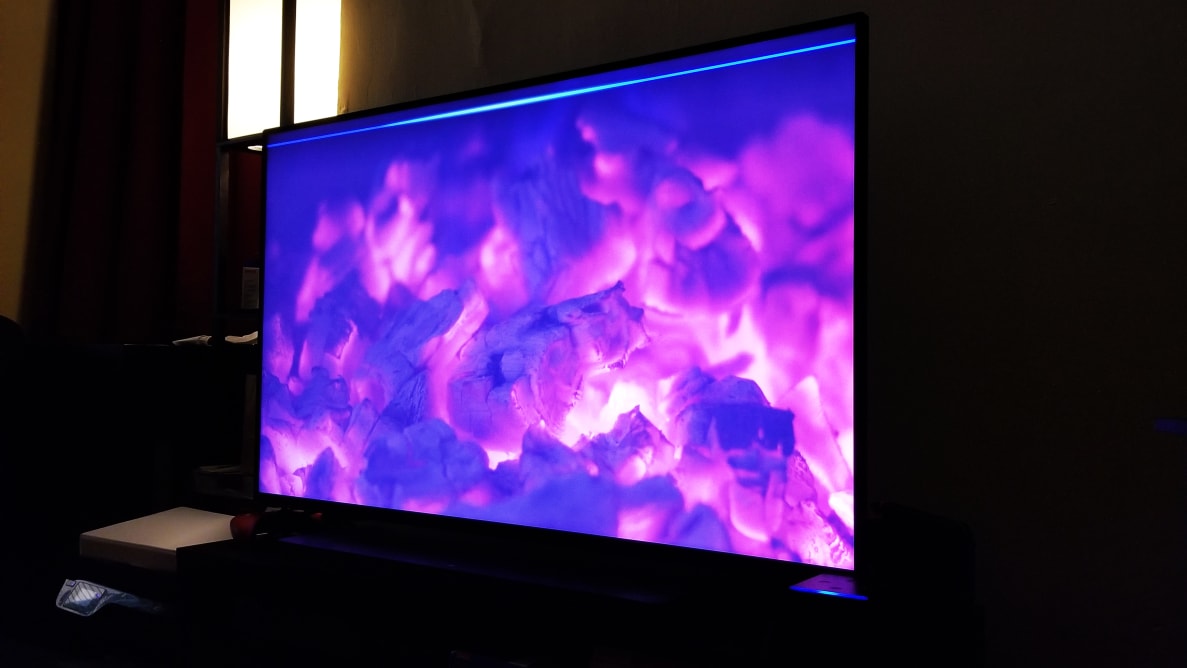Pros
-
Able to control all your smart devices
Cons
-
Unreliable voice control
-
Expensive
About the Amazon Fire TV Cube (2nd. Gen)
The new Amazon Fire TV Cube (2nd. gen) is available on Amazon as of Thursday, October 10th, 2019 for $129 (the first gen model is down to around $90 online). Like the previous model, the new Cube proffers a hands-free experience via Alexa voice command integration, and primarily improves upon the speed and "snappiness" of the first gen. version via better processing and internal components.
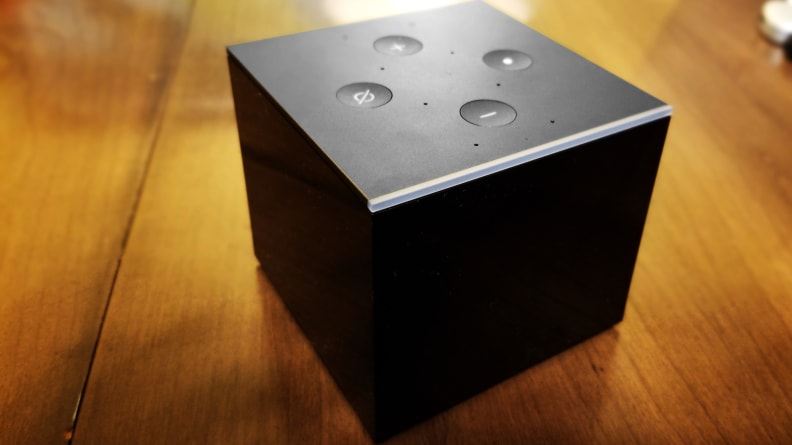
Meet the second generation Amazon Fire TV Cube.
In the box, you're getting the Cube itself, an Alexa-compatible voice remote, an ethernet adapter, an IR extender cable, and a power adapter—an identical accessory set to the first gen. model. Likewise, the 2nd gen. Cube continues to offer support for streaming in 4K, HDR, HDR10, HDR10+, HLG, and Dolby Vision—essentially every version of the High Dynamic Range format available on the consumer market.
As a series, the Cube models also boast a suite of options that put them ahead of the more affordable Amazon Fire streaming devices like the Fire TV Stick and Fire TV Stick 4K. For one, the Cube has a built-in speaker, as well as far-field voice control over the device itself and connected compatible devices like soundbars. Like other Fire TV devices, you can connect it directly to Bluetooth headphones.
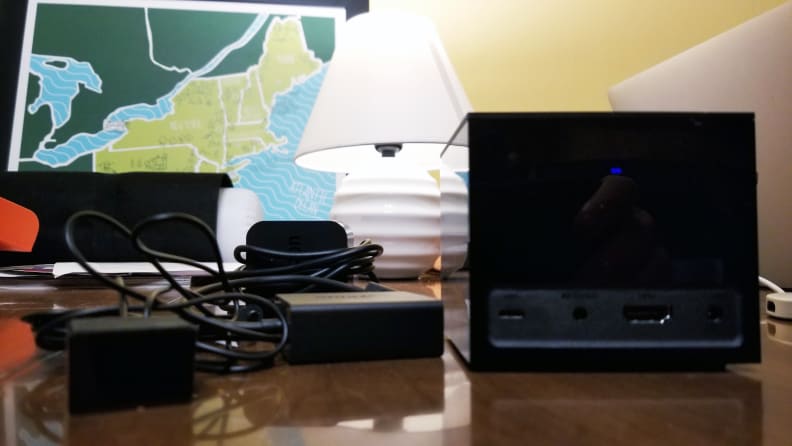
In the box, you'll get the Cube itself (pictured: the back, with power, IR extender, USB, and HDMI ports), an ethernet adapter, an IR extender, and a power cable. Note that there's no HDMI cable included.
Essentially, the Cube acts like a Fire TV Stick and an Amazon Echo speaker in one, able to take your voice commands and immediately control your TV. While you could do technically achieve this via separate Echo and Fire TV devices, this is a more affordable way to do it, and also gets you the IR extender and HDMI-CEC abilities.
Now that you've got a solid understanding of what this device is and what it's supposed to do, let's talk about how it actually works.
What We Like
There's something altogether pleasing about the Cube's design
Devices that stream media to your TV come in many shapes and sizes. From the tiny Roku stick to the humongous Xbox One, we have a plethora of ways to watch Netflix, Hulu, Prime Video, and YouTube—amongst many other things. I like to think at some point in Amazon's product design division, after the moderate success of the Fire TV Stick, somebody was like, "Alright, how do we make a big standalone box? Well, no one's done a cube yet." And voila, the Fire TV Cube was born. Or something like that.
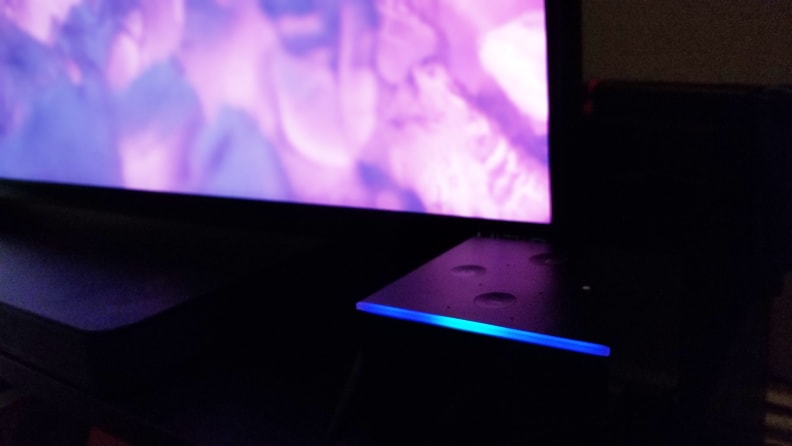
The monolithic Fire TV Cube presents a pleasing symmetrical aesthetic. The top of the Cube features embedded far-field microphones, control buttons, and the familiar "Alexa" strip.
In any case, it's an aesthetic that's inherently pleasing, if only for its symmetry. The top of the cube is dotted with microphones to make far-field voice commands possible, and four cardinally oriented buttons for power, volume control, and turning the microphones on/off (useful if, for example, you have a family member named Alexa—or you're just anxious about Amazon listening in on your conversations). The bottom of the cube features a speaker that fires into the tabletop surface, and 'round back you'll find all your inputs: a mini USB input for the ethernet adapter, an input for the included IR extender cable, an HDMI out, and the power port.
Note that while you're getting almost everything you need to use the Fire TV Cube 2nd gen. like a pro, you aren't getting an HDMI cable to run it to your TV. While a lot of people have these laying around these days, it's worth making note of. Perhaps Amazon is hoping you'll steal the old one from your previous, worse streaming device.
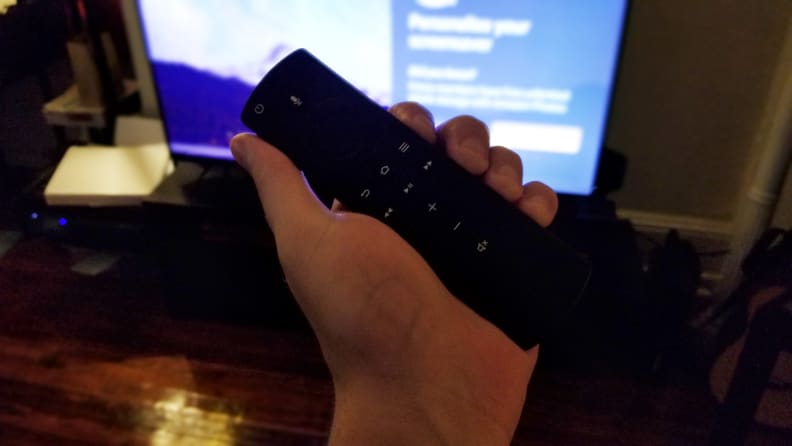
The included remote is about as minimalist as the Cube itself, featuring a few key buttons in a matching white-on-black aesthetic.
From the Cube, to its accessories and remote, the design/materials of everything here feels as premium as it can for a device like this. All your cables and adapters say "Amazon" prominently, and are of a matching matte black aesthetic. The Cube is as monolithic as you'd expect, save its four top-mounted buttons, rear inputs, and a thin LED strip along the front top corner that lights up in a shade of blue during voice use, in the familiar fashion of other Amazon devices like the Echo.
A quick, clean, intuitive streaming solution
Setting up and getting down to business (re: streaming Netflix et al) via the new Fire TV Cube is an easy as peanuts process. You can certainly fiddle with the adapters and such if you need to, but all you need to do is plug the Cube into the wall and grab an HDMI cable to plug it into your TV (I stole our Nintendo Switch's HDMI cable—I'm-a sorry, Green Mario). Naturally, you'll be prompted to sign into your Amazon account and add a few apps to the pre-installed selection.
Well, in theory, it's easy as peanuts. I had to re-pair the Cube's remote with the device and reboot once after it froze on the location selection screen, but after that (and a quick remote update), I was ready to roll. The circle-pad navigator on the remote is precise and easy to use, and plugging in my passwords for my WiFi and Amazon accounts was surprisingly painless. Of course, as soon as I could, I abandoned the remote's buttons to use voice commands.
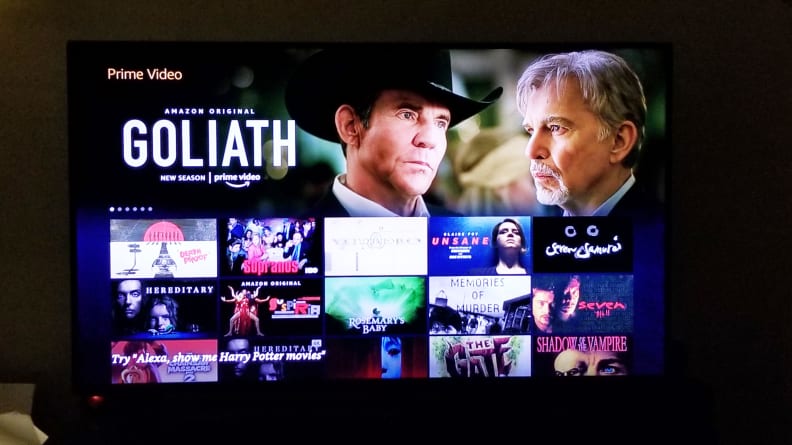
The Fire TV Cube's software is laid out in a TV-screen-friendly manner, with big clickable tiles. Naturally, Prime Video content is pretty prioritized.
I'll be honest: I'm not an Alexa expert. I barely use voice commands in my day-to-day life for anything, and I don't have any smart home stuff at home. I've used the Echo and the Dot before, albeit sparingly, so I wasn't initially sure I'd use the Cube's remote mic or on-set microphones as much as I just clicked around with the remote. So you can imagine my delight when I discovered how accurate and easy it was to use the remote for voice commands.
I recently upgraded from a 1080p TV to a 4K/HDR TV, and one of the biggest draws of the 2nd gen. Fire TV Cube for me was that it allowed 4K/HDR streaming natively. I knew there was already content graded to those formats on Prime Video, so I held the voice button down and asked, "Show me HDR content." Within a moment, a string of UHD/HDR content popped up on screen. At a glance, not all of it was HDR, and most of it was on Prime Video natively—but having not linked Netflix yet, this wasn't super surprising.
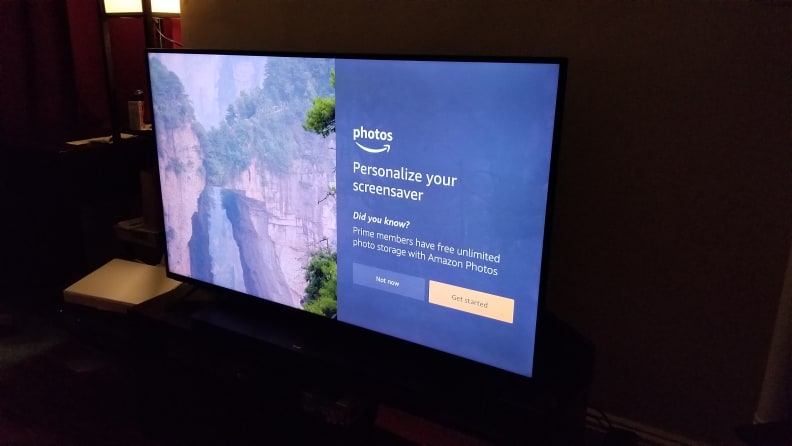
A screensaver comes up (which, naturally, integrates with Amazon Photos) if you don't do anything for a few minutes. In my opinion, it doesn't last long enough before the screen goes black.
Next, I noticed that the Cube was still outputting in 1080p, and using voice, I tried to stump it with laziness and just said "Go settings." Naturally, it still worked, and I was able to set the resolution to "Auto," taking advantage of all my TV's pixels. I was also happy to see audio settings for volume leveling and dialogue enhancement.
One odd thing about the Cube that sets it apart from other streaming devices I've used (which is most of them) is that Netflix isn't installed automatically. It appears on the Home screen with a little cloud next to it, meaning its available, but you'll still have to download it, sign in, and of course pay a subscription fee. All of this is par for the course if you've used a media streaming device before, but it's worth mentioning for newcomers.
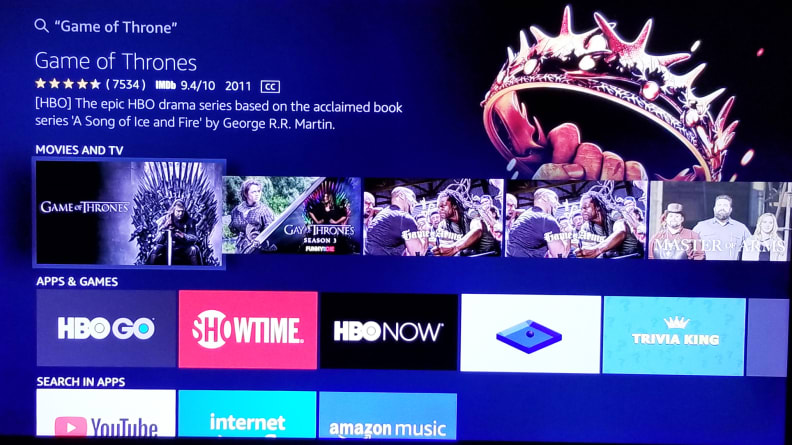
Alexa only heard "Game of Throne," but still brought me to the right page regardless.
I've been rewatching Game of Thrones recently, so I decided to do a search for that. This is one area where the Cube stumbled a bit, though it still got me where I was going. I gave it more of a sentence structure and said, "I'd like to watch Game of Thrones." What Alexa heard was "Game of Throne," which, while technically inaccurate, still brought me to the show (or rather, ways of accessing it).
Overall using the Cube to find and stream media is a delightfully easy experience. Of course, it can't know inherently by which platform you plan to watch a show. I've been rewatching GoT on Hulu via an HBO add-on, so the prompts of HBO Now weren't useful for me, for example. But overall, it's easily the laziest streaming device I've had the pleasure of using in many moons.
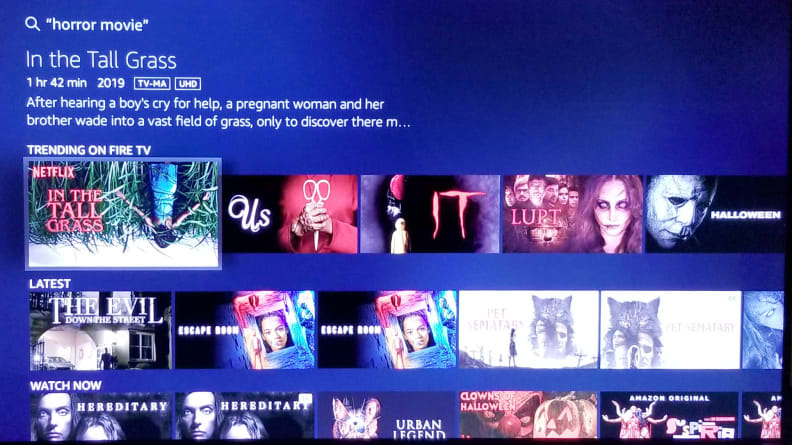
Say "Alexa, show me horror movies," and the Cube will show a list of spooky films—granted, most of them are Prime Video picks, but that's to be expected.
What We Don't Like
Mostly smooth, but not totally free of hitches
While the 2nd gen. Cube was probably the easiest experience I've had finding and streaming content (the ability to use your voice only is pretty wild), it wasn't (or isn't) without some quirks. When I first plugged the Cube in and powered it on, it wouldn't send a signal to the TV at all. Then when it did boot up, it froze on the "select your location" screen, and I had to re-pair the remote after unplugging it to get things working again.
While this kind of thing isn't unheard of with streaming devices, it was a little wonky feeling for a $120 box. As of those initial issues I haven't had any other problems searching or getting the device to boot up (it automatically switches on when you jump to its HDMI input on your TV via "hot plug," a 5-volt HDMI charge that signals power).
Deep app searching still isn't possible (apparently)
While the Cube's voice search functionality is on par with the best voice command devices out there, the ability to use it to locate precise things within apps from outside of apps still doesn't seem possible. Let me explain.
Earlier I mentioned that I've been watching Game of Thrones via the Hulu add-on. When I ask Alexa to "show me Game of Thrones" or anything like that, it brings me to an OTT (over-the-top) collection of related things. Clicking on the show, I'm told I can buy episodes or seasons via Prime Video, or can watch it on proprietary HBO apps like HBO Now and HBO Go.
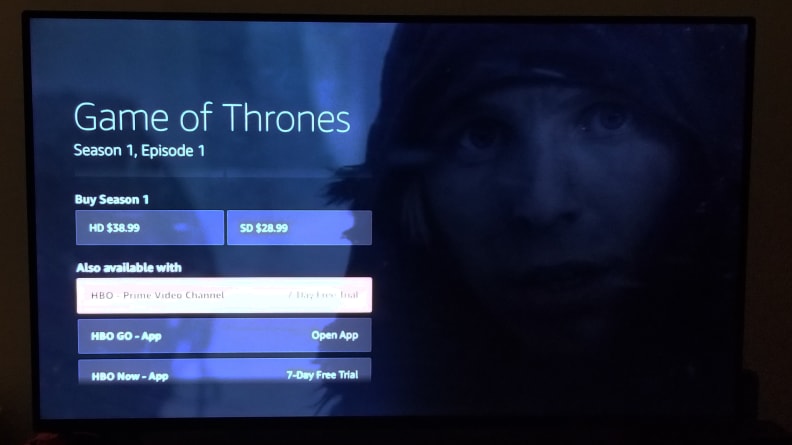
Despite that I watch Game of Thrones via the HBO add-on on Hulu, the Cube won't recommend it when I search for it, and generally isn't deeply familiar with app integration beyond one level of search.
While that's fine, the fact that I can't jump to it directly from outside of Hulu is a bit of a shame. Sure, it's only one or two more voice (or remote) prompts to get there, but it would be nice if the device could develop a more nitty gritty sense of what is available within streaming apps. Admittedly this is a complicated ask, but still.
Alexa doesn't always understand
Generally, Alexa knows what I'm asking or saying, but every now and again, even with the best annunciation I can mutter, she gets it a little wrong.
I did an experiment and tried using the device entirely hands-free for a few things. First, I said "settings" and went to settings, then tried to go to "display and sound" to adjust some things. Instead, Alexa went to sleep sounds, and I ended up listening to some calming ocean waves. Granted the experience was fine, but it was a strange mistake to make.
Next, I decided to try out YouTube. I said, "Alexa, go to YouTube," only to discover the app wasn't pre-installed. I said, "Alexa, download YouTube." She said, "Here are details about this app. Would you like to start downloading?"
"Yeah." ... "Yes." ... "YEP."
Nothing.
"Download this app."
Finally, it started downloading. While sitting at my kitchen table about 12 feet from the TV writing this, I noticed the app had finished downloading. Thankfully, the far-field microphones are good enough that I was able to say, "Hey Alexa, open YouTube" from my place in the other room. I said, "Alexa, use YouTube signed out," and it searched for "how to use YouTube signed out," which wasn't what I meant but somehow achieved what I wanted anyway.
Then, attempting to search for a 4K bonfire video (it's getting cold in Philly), Alexa didn't search YouTube but simply searched everywhere. I got what I wanted again, but again, not by the means I intended.
Should You Buy It?
The Cube swings for the fences, but right now the verdict is "maybe"
Having only had a couple of days to fuss around with the 2nd gen. Cube and not being heavily familiar with the first, it's hard to say that 1st gen. Cube owners have anything to be excited about. The processing, speed, and downloading of apps or navigating through menus is very snappy this time around, and Alexa remains responsive and (at times) surprisingly intelligent, even if she fumbles on occasion.
While Amazon's Fire TV line continues to be an excellent choice for existing Prime subscribers, it's hard to say that the 2nd. gen Cube is outright the best choice over competition like Roku and Apple TV. We've loved Roku's platform-agnostic approach to streaming for years, and the Cube's occasional ads for Amazon Photos or tendency to push content on Prime Video to the top of the list didn't go unnoticed while I was using it. There are also lots of other 4K streamers out there to choose from these days: Apple TV 4K, Roku Ultra, and lots more.
If you don't already own a streaming device (or what you have is getting old, sluggish, or isn't 4K-compatible), updating to the new Cube is probably a smart move. Kudos to the design for allowing entirely hands-free use (even if, for some of us, we start to feel like we're shouting into a void while home alone all day with the thing). I can't help but feel like $120 is a bit higher than I'd normally want to pay for an easier way to watch Netflix et al than booting up my Xbox, but I probably would feel differently if I was using the Cube to control other Alexa-compatible devices like a soundbar or speaker system, or to interface with existing smart home products. The ability to use Alexa natively to control other devices is pretty key here, and I haven't gotten to experience that enough to comment on it (yet).
With new Rokus out this week, it's impossible to responsibly recommend that streaming device hopefuls rush onto Amazon to buy the 2nd. gen Cube, but I also don't think you'd be foolish if you did. If I was keeping this unit I'd likely start using it in place of my Xbox One outside of playing games, and for me, that's saying something. If you do pick one up this week, just be sure to carefully read the instructions about placement: this device relies on its embedded microphones and IR control to become the hub of your media room, and Amazon includes some pretty specific instructions about how it will and won't place nice with your devices.
Meet the tester
Lee was Reviewed's point person for most television and home theater products from 2012 until early 2022. Lee received Level II certification in TV calibration from the Imaging Science Foundation in 2013. As Editor of the Home Theater vertical, Lee oversaw reviews of TVs, monitors, soundbars, and Bluetooth speakers. He also reviewed headphones, and has a background in music performance.
Checking our work.
Our team is here to help you buy the best stuff and love what you own. Our writers, editors, and experts obsess over the products we cover to make sure you're confident and satisfied. Have a different opinion about something we recommend? Email us and we'll compare notes.
Shoot us an email